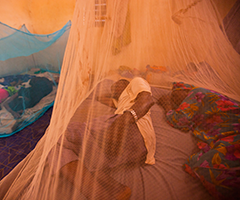A mosquito net enters a household through a mass distribution campaign and quickly becomes a prized possession. It is aired out for a day or two, then hung over the bed. A mother and her two children sleep under it. In the morning, mom ties the net up so that her toddler doesn’t use it for climbing.
Every so often she washes the net to remove dust and dirt and hangs it back up. Later on it tears a little bit—the tear widens each time she tucks the net under her sleeping mat. Finally her toddler does manage to yank it and make a big hole. When the next mass campaign comes, she throws out the old net and hangs up the new one.
And that, CCP researchers have found, is the typical lifecycle for a mosquito net in four sub-Saharan African countries. The study, recently published in Malaria Journal, is the first to quantify the extent of mosquito net misuse, and the findings are very encouraging for donors and malaria programs alike.
Using 14 different household surveys, researchers explored what happens to mosquito nets when they leave a household. They found that two thirds of nets are discarded only after they are old, torn and no longer suitable for malaria prevention. The remaining third are given away to family or friends, primarily right after distribution.
Contrary to persistent anecdotal reports, more than 99% of the 25,000 nets in the study were being used for their intended purpose. Furthermore, the nets that were used for other purposes (protecting seedlings from animals; enclosing latrines) were primarily old nets that had served out their useful lifespan protecting their owners from malaria.
Like previous research done under the NetWorks project, this study demonstrates that individuals are using nets for malaria prevention to a much greater extent than previously thought.





